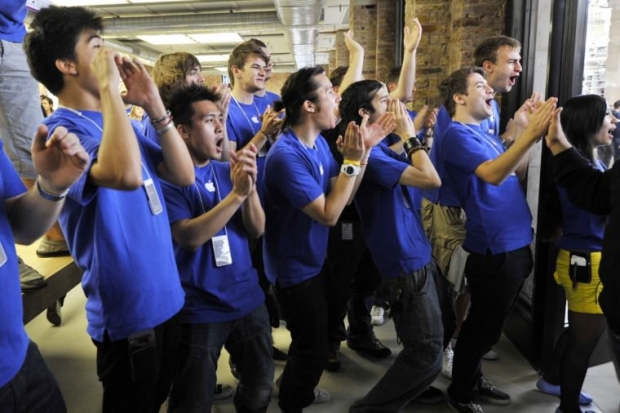Bloomberg is reporting that legions of Apple customers are venting on social media, customer forums and chatting to hacks about how disappointing Apple stores are.
Current and former Apple employees say the stores have become mostly an exercise in branding and no longer do a good job serving shoppers like Smith.
Staff quality has slipped during an 18-year expansion that has seen Apple open more than 500 locations and hire 70,000 people. The Genius Bar has been largely replaced with staff who roam the stores and are harder to track down.
Bloomberg thinks that this might be one reason people are hanging onto their phones. After all, it can’t be that Apple phones are not what they used to be.
Problems at the stores probably are not helping sales. Chief Executive Officer Tim Cook announced that retail chief Angela Ahrendts was leaving and would be succeeded by veteran Apple executive Deirdre O’Brien
Apple stores were developed by Ron Johnson, a former Target executive. During his tenure, Johnson oversaw the opening of 350-plus stores and expansions into more than a dozen countries, including Japan, Australia, Italy, China and Canada. Then, in 2011, he left to reboot the department store chain J.C. Penney which did not really work as well.
He was replaced in early 2012 by John Browett, who had previously run the British electronics chain Dixons. Browett pushed accessories and warranties. That boosted sales but weakened a culture that preferred to help customers rather than sell to them. Browett fired workers, cut the hours of others, reduced overtime and promoted fewer people. Cook fired him and ran the retail operation himself until Ahrendts started in May of 2014.
The former Burberry chief’s hiring was cheered by the Tame Apple Press. She had a history of peddling expensive fashion items to those with more money than sense. Under Ahrendts, the stores began to resemble jewellery emporiums.
It was Ahrendts’ first move to turn the stores into “Town Squares” where shoppers could hang out and, in industry parlance, “spend time with the brand”. Customer service counters were replaced with Genius Groves, tables and roaming Geniuses so that there would not be any queues. Checkout counters disappeared in favour of salespeople armed with mobile devices.
Meanwhile, sales and service were moved onto the web. Customers were to make an appointment on Apple’s website and then pick up the product at a store. All this self-indulgent brand-toss turned out to be as useless as it sounds. It made life difficult for customers who wanted to buy the products.
Until then Apple wanted you in and out of the store like an SAS mission. Jobs himself liked that idea – it limited actual contact with the great unwashed.
Under Ahrendts punters looking for technical advice or repairs must now check in with an employee, who types their request into an iPad. Then when a Genius is free, he or she must find the customer wherever they happen to be in the store. While this got rid of queues, the stores are packed with people waiting for their iPhones to be fixed or batteries swapped out.
Staff training on the gear is also pretty rubbish as the focus is hiring nice people rather than those who know what they are talking about. Under the Johnson era, sales associates got three weeks to a month of training - now they get about a week if they’re joining an existing store. Geniuses, who earn $22 an hour on average, according to Glassdoor, were trained at Apple’s Cupertino, California, headquarters. Now they’re mostly trained in stores.
Since she has left, Apple began moving away from her strategy. Stickers and poster boards appeared in stores pushing new devices and initiatives—anathema to Ahrendts’s less-is-more philosophy. The pricey, special edition watches were long gone, and Apple had introduced lower-priced handsets like the iPhone XR.
Apple’s new retail chief recently embarked on a listening tour of the stores although it is clear that she is trying to hide any ill feeling. Her Instagram feed is filling up with happy snaps with employees she encountered in Paris, Hong Kong and Austin, Texas. But she should know the score she set up the stores with Jobs, Johnson and Cook.




